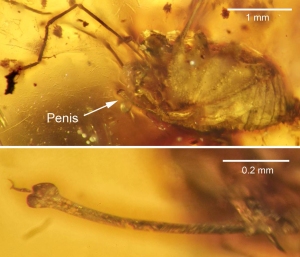By Jillian Jennett
Staff Writer

A 99-million-year old ancestor of the harvestman spider, better known as the “Daddy Longlegs,” was fossilized in amber and all it got was a perfectly preserved, fully erect penis.
The spider, known as Halitheres grimaldii, lived in what is now Myanmar nearly 100 million years ago. The H. grimaldii is different than other arachnids in its anatomy. Most species in its class reproduce by transferring sperm through small packets from the male to the female in a neat, tidy process.
Harvestman spiders use a more familiar reproductive process. Almost all harvestman spiders have penises, which they insert into their mate’s genital opening, close to the mouth.
Actually, a harvestman spider’s penis is approximately half its body length when erect, making it quite a sight when mating. The H. grimaldii used this messy method, but its hardware is a little different compared to its modern counterpart.
This species’ penis is distinctively shaped. The heart-shaped head and small twirled tip are completely different than others closely related to it.
This means that there is a distinct difference between the mating habits of this specific species in comparison to its contemporaries. This fossilized penis is evidence of this distinction.
The H. grimaldii was recently reclassified to a different family tree after this discovery. A more in-depth analysis was able to be conducted thanks to this fossil. This specific species is rarely collected, making it a prime find for scientists.
So why was this spider found like this, fossilized forever in this state? Scientists noted that there was no female trapped with this H. grimaldii, which could mean any number of tragic endings.
One possibility could be that the two who were about to mate were separated by the sap leaking from the tree. Another could be that it was trying to defend its territory and attempted to display its dominance.
Perhaps the most likely event is that the H. grimaldii was simply terrified, causing this permanent state of arousal. Tense situations could have caused its blood pressure to rise and, by extension, its penis to become engorged with blood immediately prior to its untimely, amber-trapped death.
I think, after 99 million years, it’s probably time for this spider to see its doctor.
























